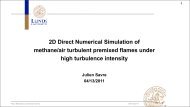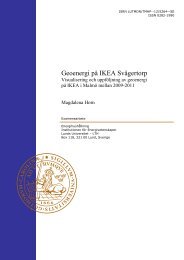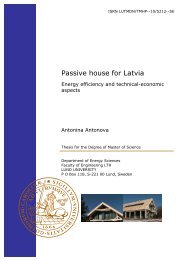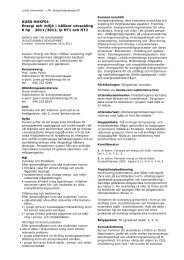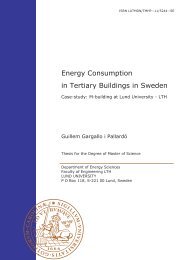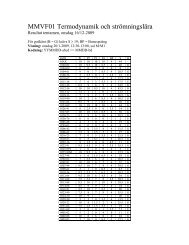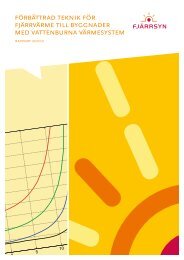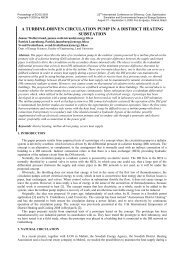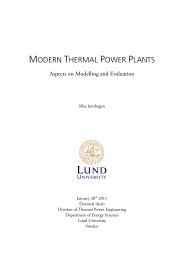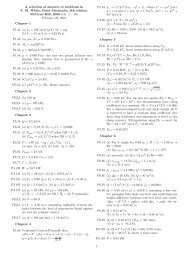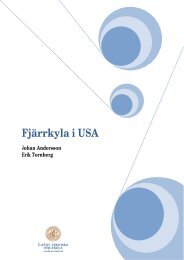Thesis for degree: Licentiate of Engineering
Thesis for degree: Licentiate of Engineering
Thesis for degree: Licentiate of Engineering
You also want an ePaper? Increase the reach of your titles
YUMPU automatically turns print PDFs into web optimized ePapers that Google loves.
cathode are assumed to be similar to the case <strong>of</strong> the reactor bed. The aim <strong>of</strong> this case study is<br />
to examine whether the kinetics used <strong>for</strong> previous models [1] fulfill these criteria so no<br />
limiting effects occur <strong>for</strong> the heat and mass transport.<br />
The macroscale (2D) computational fluid dynamics (CFD) model <strong>of</strong> an intermediate<br />
temperature anode-supported SOFC operating on 30% pre-re<strong>for</strong>med natural gas is the base<br />
<strong>for</strong> the calculations per<strong>for</strong>med here. First, the criteria <strong>for</strong> the different domains are described<br />
and defined below. Then, the results <strong>of</strong> the analysis <strong>for</strong> the SOFC are presented in the next<br />
chapter.<br />
3.3.1 Interparticle transport<br />
The largest scale in this analysis is <strong>for</strong> the interparticle transport which is also sometimes<br />
called intrareactor scale because it applies to gradients within the reactor as a whole.<br />
Transport phenomena can occur both radially and axially within the reactor and these are hard<br />
to control and evaluate. For the SOFC the axial direction refers to the main flow direction (xdirection)<br />
and the radial direction refers to the direction normal to the main flow direction (ydirection).<br />
But if neglected, radial temperature gradients can <strong>for</strong>ce the reaction rates to be<br />
thousandfold greater <strong>for</strong> parts <strong>of</strong> the reactor <strong>of</strong>ten close to the axis [49]. For the SOFC this<br />
would occur in the anode and near the electrolyte close to the inlet <strong>of</strong> the cell and would mean<br />
a risk <strong>for</strong> disturbing “hot spots”. This can be checked by radial dispersion [50]:<br />
(3.38)<br />
where Bi R is the Biot number based on the reactor diameter, ΔH the enthalpy change <strong>of</strong><br />
reaction, r r the reaction rate, R o the reactor diameter, k e the thermal conductivity <strong>for</strong> the solid<br />
porous media, T w the temperature at the solid surface and γ the dimensionless activation<br />
energy. The axial dispersion is a less frequent limitation in a severe manner. Axial<br />
temperature gradients and axial conduction are possible to neglect if the length-to-particle<br />
diameter ratio is large enough (L/d p > 30) which is the case <strong>for</strong> SOFCs [50]. The criterion <strong>for</strong><br />
the limitation <strong>for</strong> the temperature gradient across the reactor diameter is defined as [49]:<br />
(3.39)<br />
where the parameters are the same as <strong>for</strong> equation (3.38) except the Biot number, R the gas<br />
constant and E a the activation energy.<br />
Mears [49] described an approach to adopt a differential reactor and this seems to be a very<br />
useful approach <strong>for</strong> the SOFC reactor beds. A differential reactor consists <strong>of</strong> different<br />
amounts <strong>of</strong> catalyst throughout the reactor bed to compensate <strong>for</strong> unfavorable effects such as<br />
extremely high reaction rates in parts <strong>of</strong> the reactor. For the SOFC one would wish to level<br />
out the reactions and the electricity generating action over the whole bed. This can be<br />
achieved by either increasing the amount <strong>of</strong> catalyst or to use finer particles to increase the<br />
reaction rate. However, the SOFC has contradicting needs <strong>for</strong> the reaction rates depending on<br />
whether the focus is on the methane steam re<strong>for</strong>ming reaction or electrochemical reactions.<br />
For the steam re<strong>for</strong>ming reaction, the reaction rate is very high at the inlet and then gradually<br />
decreases in the flow direction <strong>for</strong> the cell. But the reaction rate <strong>for</strong> the electrochemical<br />
reactions requires a higher reaction activity right at the inlet <strong>for</strong> a limited area which would<br />
increase if more catalyst material was provided or finer particles were present. By adjusting<br />
the reaction rate activity <strong>for</strong> its needs, severe effects <strong>of</strong> temperature or concentration gradients<br />
could be minimized.<br />
31



